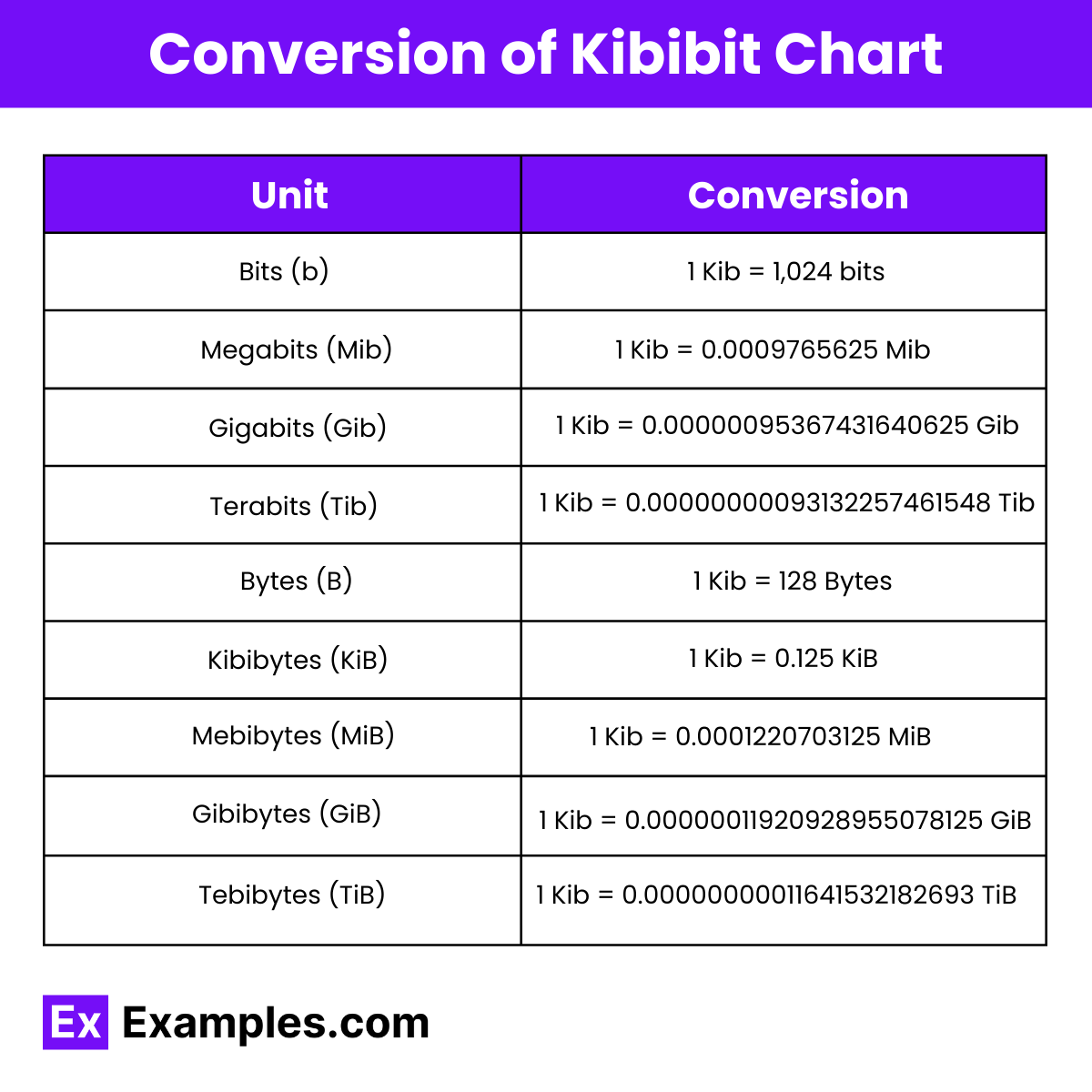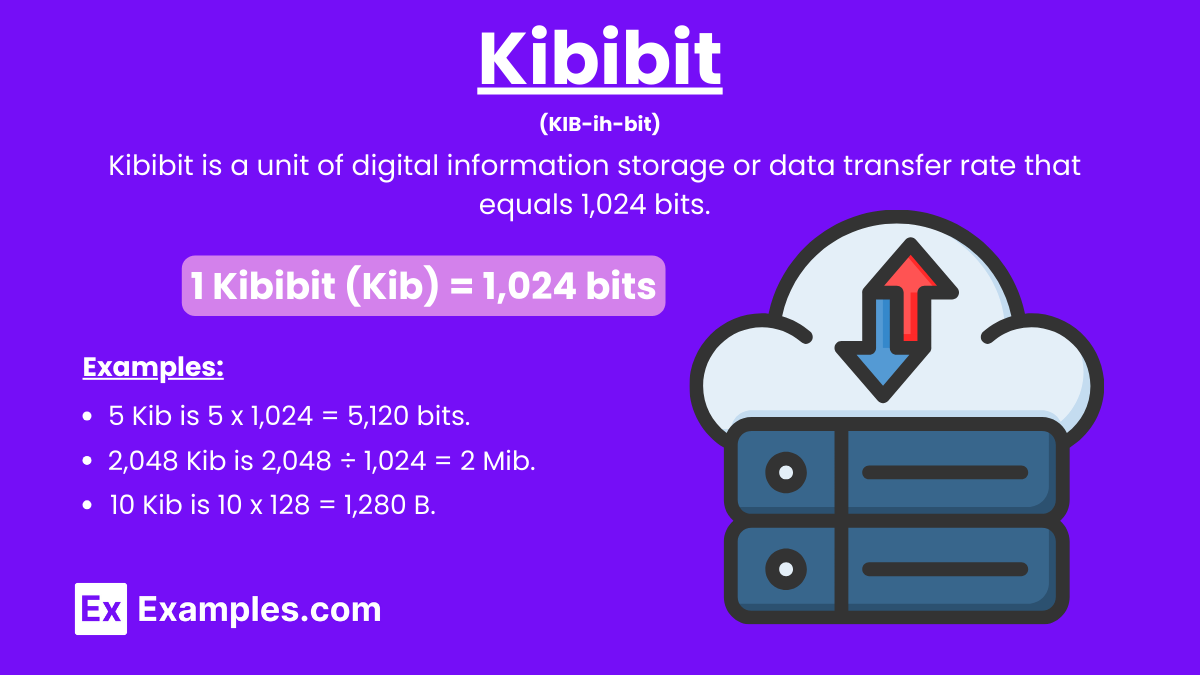Kibibit – 9+ Examples, Conversion Chart, Differences, Uses
Kibibit is a unit of digital information storage or data transfer rate that equals 1,024 bits. It is based on the binary system, which is widely used in computing and digital communications. The term “kibibit” is derived from the combination of “kilo” and “binary digit,” emphasizing its alignment with the binary (base-2) numeral system. In different contexts, other units of speed are used, such as foot per second, meter per second, and miles per second, to measure the velocity of objects. Each of these units provides a specific way to understand the rate at which something moves over a given second, whether it’s data through a network or physical objects in motion.
What is Kibibit?
A kibibit is a unit of digital information that represents 1,024 bits. Unlike the kilobit, which equals 1,000 bits and is based on the decimal system, the kibibit uses the binary system commonly used in computing. The name “kibibit” combines “kilo” and “binary digit,” indicating its alignment with the base-2 numeral system. Understanding units of measurement is essential in various fields, including data transfer rates. Different measurement units are used to quantify speed and length, such as meters or feet. A measurement chart can help convert between these units, ensuring accuracy and clarity in communication.
How Big is a Kibibit?
1 Kibibit (Kib) = 1,024 bits
1 Kibibit (Kib) = 128 bytes
1 Kibibit (Kib) = 0.125 kilobytes (KB)
Conversion of Kibibit into Other Units

| Unit | Conversion from Kibibit (Kib) |
|---|---|
| Bits (b) | 1 Kib = 1,024 bits |
| Megabits (Mib) | 1 Kib = 0.0009765625 Mib |
| Gigabits (Gib) | 1 Kib = 0.00000095367431640625 Gib |
| Terabits (Tib) | 1 Kib = 0.00000000093132257461548 Tib |
| Bytes (B) | 1 Kib = 128 Bytes |
| Kibibytes (KiB) | 1 Kib = 0.125 KiB |
| Mebibytes (MiB) | 1 Kib = 0.0001220703125 MiB |
| Gibibytes (GiB) | 1 Kib = 0.00000011920928955078125 GiB |
| Tebibytes (TiB) | 1 Kib = 0.00000000011641532182693 TiB |
Just as KBps is used to measure data transfer rates, other units of measurement like yard, centimeter, and millimeter are used to quantify length in various contexts. Using a measurement chart helps convert between these units, providing clarity and precision in different fields of study and application.
Understanding how to convert data storage units to other common units is crucial when dealing with different data capacities, whether you’re configuring storage settings, comparing data sizes, or ensuring accurate data rates for projects. Here’s a straightforward guide to converting data storage units to and from other common units:
Kibibits (Kib) to Bits (b)
Multiply the Kib value by 1,024 to convert to Bits.
Example: 5 Kib is 5 x 1,024 = 5,120 bits.
Kibibits (Kib) to Megabits (Mib)
Divide the Kib value by 1,024 to convert to Megabits.
Example: 2,048 Kib is 2,048 ÷ 1,024 = 2 Mib.
Kibibits (Kib) to Gigabits (Gib)
Divide the Kib value by 1,048,576 to convert to Gigabits.
Example: 2,097,152 Kib is 2,097,152 ÷ 1,048,576 = 2 Gib.
Kibibits (Kib) to Terabits (Tib)
Divide the Kib value by 1,073,741,824 to convert to Terabits.
Example: 2,147,483,648 Kib is 2,147,483,648 ÷ 1,073,741,824 = 2 Tib.
Kibibits (Kib) to Bytes (B)
Multiply the Kib value by 128 to convert to Bytes.
Example: 10 Kib is 10 x 128 = 1,280 B.
Kibibits (Kib) to Kibibytes (KiB)
Divide the Kib value by 8 to convert to Kibibytes.
Example: 32 Kib is 32 ÷ 8 = 4 KiB.
Kibibits (Kib) to Mebibytes (MiB)
Divide the Kib value by 8,192 to convert to Mebibytes.
Example: 16,384 Kib is 16,384 ÷ 8,192 = 2 MiB.
Kibibits (Kib) to Gibibytes (GiB)
Divide the Kib value by 8,388,608 to convert to Gibibytes.
Example: 16,777,216 Kib is 16,777,216 ÷ 8,388,608 = 2 GiB.
Kibibits (Kib) to Tebibytes (TiB)
Divide the Kib value by 8,796,093,022 to convert to Tebibytes.
Example: 17,592,186,044 Kib is 17,592,186,044 ÷ 8,796,093,022 = 2 TiB.
Difference Between Kibibit and Kilobit
| Feature | Kibibit (Kib) | Kilobit (Kb) |
|---|---|---|
| Definition | 1 Kibibit = 1,024 bits | 1 Kilobit = 1,000 bits |
| System | Binary (Base-2) | Decimal (Base-10) |
| Abbreviation | Kib | Kb |
| Conversion to Bits | 1 Kib = 1,024 bits | 1 Kb = 1,000 bits |
| Conversion to Bytes | 1 Kib = 128 bytes | 1 Kb = 125 bytes |
| Conversion to Kilobytes | 1 Kib = 0.125 Kilobytes (KB) | 1 Kb = 0.125 Kilobytes (KB) |
| Usage | Digital storage and memory | Telecommunications and data transfer |
| Usage Example | Memory size (e.g., 512 Kib) | Internet speed (e.g., 100 Kb/s) |
Where do you use of Kibibit
- Computer Memory and Storage: Kibibits are used to measure data in computer memory and storage systems. This includes RAM, cache memory, and storage devices such as SSDs and HDDs. Using binary-based units like kibibits ensures precision in describing memory and storage capacities.
- Networking: Kibibits per second (Kibps) are used to measure data transfer rates in networking, especially in environments where precise binary measurement is necessary. This can include internal data center networks, enterprise networks, and specific network segments.
- Data Transfer Measurement: Kibibits are used to measure data transfer rates in scenarios requiring precise binary measurements. This can include transferring data between servers, storage devices, and other hardware within computing environments.
- Telecommunications: In telecommunications, kibibits may be used to specify data transfer rates for certain applications where binary precision is critical. This can include specialized communication links, legacy systems, and infrastructure components.
- Embedded Systems and Firmware: Kibibits are used in embedded systems and firmware development to describe the size of code and data storage requirements. Precise measurement is crucial in these applications to optimize performance and resource utilization.
- Network Monitoring: Network administrators use kibibits to monitor and analyze data transfer rates in binary-based computing environments. Tools and software for network performance monitoring often display data rates in Kibps to ensure accuracy.
- Scientific Research and High-Performance Computing (HPC): In scientific research and HPC, kibibits are used to measure data transfer rates and storage capacities. High precision is required for managing large datasets and computational tasks, making kibibits suitable for these applications.
Who introduced the term Kibibit?
The term Kibibit was introduced by the International Electrotechnical Commission (IEC) in 1998.
What is the abbreviation for Kibibit?
The abbreviation for Kibibit is Kib.
How many Kibibits are in a Mebibit?
There are 1,024 Kibibits in a Mebibit.
What is the relationship between Kibibits and Kibibytes?
A Kibibit is equal to 1/8 of a Kibibyte.
Where is the term Kibibit commonly used?
The term Kibibit is commonly used in computing and digital storage contexts.
What is the decimal equivalent of a Kibibit?
A Kibibit is approximately equal to 1,024 bits in decimal notation.
Is a Kibibit used in network speeds?
Yes, Kibibits per second (Kibit/s) are used to measure data transfer rates.
How can I convert Kibibits to Kilobits?
To convert Kibibits to Kilobits, multiply by approximately 1.024.
What is the binary representation of a Kibibit?
A Kibibit is represented as 2^10 bits in binary.
Why was the Kibibit introduced?
The Kibibit was introduced to address ambiguity in binary prefixes for digital information.


